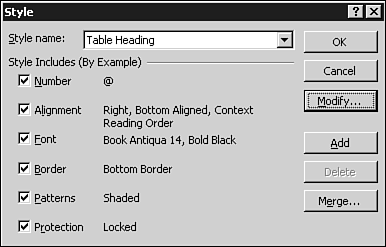Saving Formats as Named Styles
Although Excel's named styles are considerably less versatile than their equivalents in Word, you can still use this feature to reuse favorite formats. By default, every new workbook includes a set of predefined formats in the following named styles: Normal, Percent, Currency, Comma, Currency [0], and Comma [0]. (The two styles followed by [0] show whole numbers only rather than two decimal places.)
Tip from 
The Currency, Percent, and Comma buttons on Excel's Formatting toolbar actually apply the corresponding named styles. If you want to redefine any of these buttons, just redefine that style. The Currency button, for example, applies the Accounting format with two decimal places to the selected cell or range. To change the way the Currency button works, redefine the Accounting named style so that it uses a Currency format, if you want. Likewise, you can change the named Percent style to include one or two decimal places, if you prefer. See Chapter 21, "Excel Essentials," for instructions on how to save these changes as part of the default workbook format so that they are available for every new workbook you create.
You can create named styles using any format you want. This technique is a great time-saver if you continually find yourself applying the same formatting options to new worksheets:
Format a cell using the number, font, and other formatting options you want to save. Click to make this the active cell.
Choose Format, Style to display the Style dialog box shown in Figure 22.17.
Type a descriptive name in the Style Name box. Use any combination of letters, numbers, and spaces; to make sure you can read the full name, keep its total length to 30 characters or fewer.
By default, all cell formatting options are included with the style. Clear the check mark from any of the boxes below the style name to remove that option from the style.
Click the Modify button to open the Format Cells dialog box and adjust any formatting options, if necessary.
To use a named style instead of direct formatting options, choose Format, Style. Choose a style name from the drop-down list and click OK.
Styles are available only to worksheets in the workbook in which you save them. To save named styles so that they're available for all new worksheets, save them in a template. To copy styles between two open workbooks, switch to the workbook you want to copy the styles to, and choose Format, Style. In the Style dialog box, click the Merge button. In the Merge Styles dialog box, pick the name of the workbook that contains the styles you want to reuse, and then click OK.
Tip from 
If you regularly use named styles in worksheets, you can dramatically increase your productivity by adding the Style list to the Formatting toolbar. You'll find step-by-step instructions for this task in Chapter 2, "Customizing the Office Interface." Make sure you do this with the default workbook template, as defined in Chapter 21, so the new toolbar is available to all workbooks you create.
→ For more details on how to create and customize toolbars, see "Customizing Toolbars".
→ For step-by-step instructions on how to customize the default Excel workbook template, see "Changing Default Formatting for New Workbooks and Worksheets".

